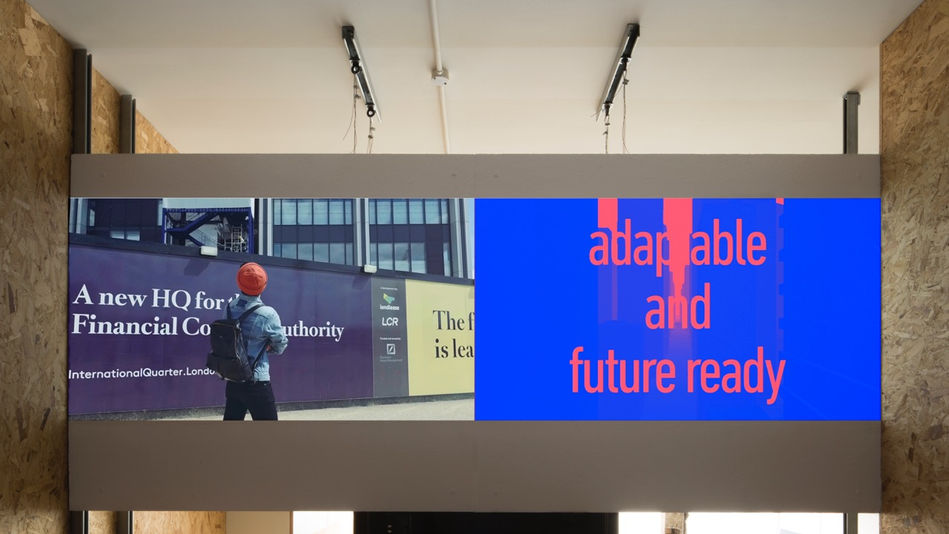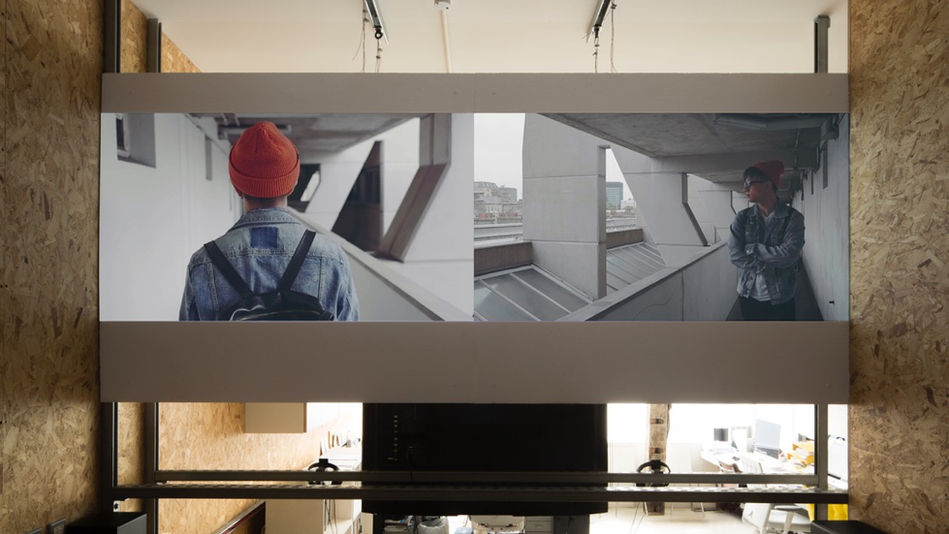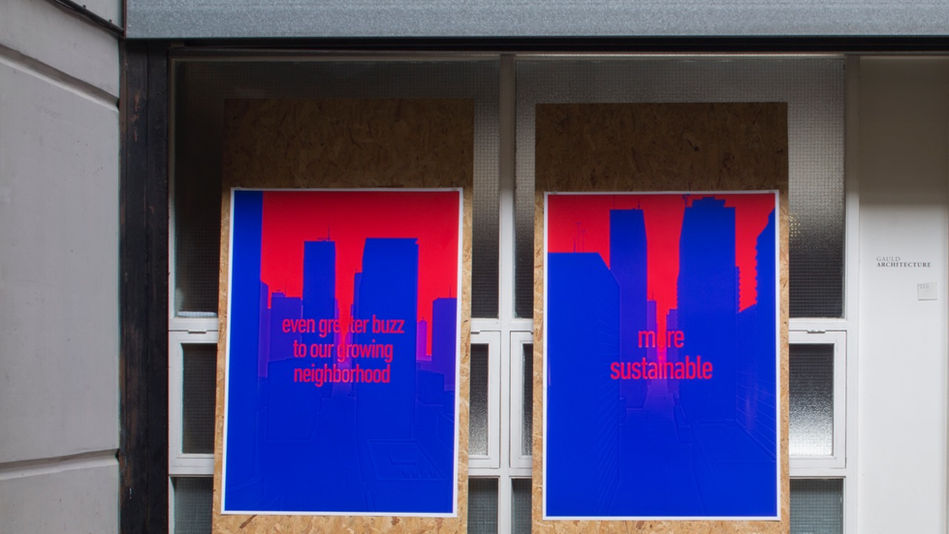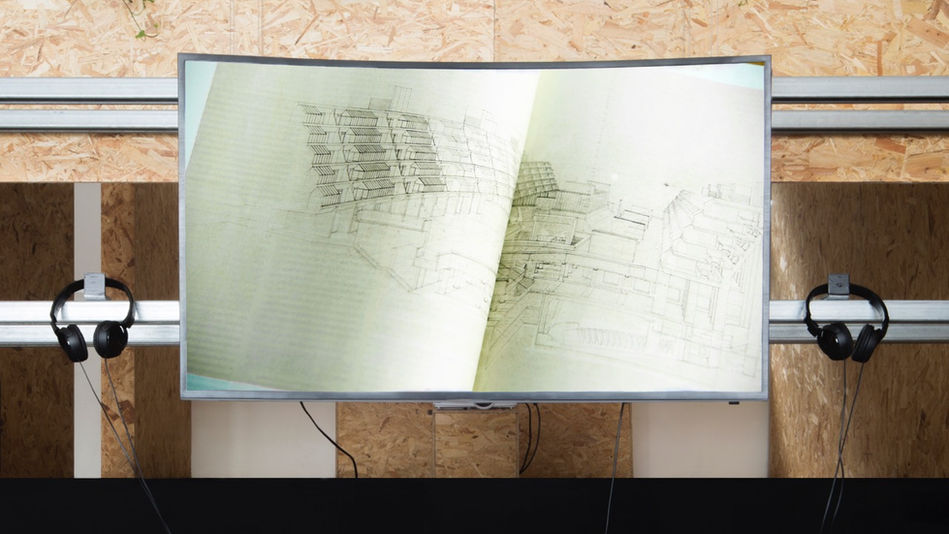The Details Are Invented
A poetic probing of gentrification in Berlin and London across time
Year
2017
Media
Multi-channel film installation
Commissioned by
Passen-gers, London

‘Our house is our corner of the world.’ —Gaston Bachelard, The Poetics of Space
Inspired by French philosopher Gaston Bachelard’s The Poetics of Space, Xiaowen Zhu presents a moving image work, The Details Are Invented. This multi-channel film is a poetic probing of the space of the Brunswick Centre, an iconic modernist, residential and commercial complex in Central London with a parallel observation of Hackney Wick and Stratford – areas of rapid gentrification in East London.
Exploring these places by following the character of a flâneur – a ‘foreigner’ who strolls the city like a walking camera, Zhu seamlessly connects public and private space, collected texts and marketing language, personal narrative and critical reflection. In times of the ongoing housing crisis and urban regeneration that is primarily driven by profits, Zhu combines these elements to share thoughts on how an individual – native or international – can make his or her home in ‘a city that’s always on the go, always in the middle of becoming something else’. (Franz Hessel, Walking in Berlin)
Mixing documentary, essay film, and video installation, The Details Are Invented intends to ask an urgent question from a historical perspective: How can we learn from history and avoid making the same mistakes? It subtly presents this angle by comparing Franz Hessel’s concerns about urban development in Berlin during the late 1920s with a similar pattern that emerged in 1980s London. Interview footage of an architect and resident of the Brunswick Centre reflects on the consequences of profit-driven urban regeneration.
The Details Are Invented was presented by Passen-gers, a site-specific exhibition series that explores the historical, social and material context of the Brunswick Centre. The project was supported by the National Lottery through Arts Council England.


Publication
Passen-gers is a site-specific exhibition series that explores the historical, social and material contexts of prominent sites and architecture. For its inaugural series artists Mark Siebert, Paula Smolarska, Evy Jokhova, Julie Hill, Theodoros Stammatogiannis and Xiaowen Zhu presented work sequentially that explored the real and imaginative associations of the Brunswick Centre – a Modernist, mixed residential and commercial development in Bloomsbury, London.
Excerpt
Review
The Details Are Invented
by Francesca Girelli
Our house is our corner of the world. This citation from Gaston Bachelard's "The Poetics of Space", which appears in the introducing statement of Xiaowen Zhu's commission for The Passengers series, provides a hint for a possible standpoint to be adopted when approaching the installation. The framework suggests that our living unit might provide the core coordinates of our situation in the world, where the word situation retains both its meanings of condition and locality, two variables strictly linked in the discourses that surround urban development nowadays. How does our social condition influence our location on the map? And how do we pinpoint the narratives that entangle real estate speculation and our lifestyle, in a city as London?
The two videos that compose Zhu's piece progressively reveal lingering leitmotifs, subtly approached but immediately evocative, both in the context of London as elsewhere in today's cities. The title, The Details are Invented prompts us to start a quest in search of the subtext, of those subliminal messages that pervade the definition of what housing means nowadays, with its social, lucrative, utopian and dystopian facets.
The video representing the first leg of the artist's response to the Brunswick has a documentary flair and, without ado, projects the viewer in the interior of one of the building's apartments from the very first frame. There, architect Brendan Woods welcomes a young visitor into his studio. The visitor is an actant Zhu identifies as a flâneur, who –almost without uttering word– embodies a discreet presence functional to the mediation of the viewer's encounter with the resident.
Woods immediately reveals the nature of his profession by introducing his working praxis and utensils of choice, a pencil bought in Paris in the 70s and tracing paper. While he distances his practice from the digital drawing tools employed in the field, the selective eye of Zhu's editing reinforces the architect's reverence for the things of the past, as he highlights the presence in the room of a 1957 Fritz Hansen's chair, and fondly points at the papier-mâché figurine that hovers above his head, bought years back in Barcelona.
The emphasis that links Woods with what might be considered as the historical, introduces a question that Zhu proposes with this piece, how can we learn from history and avoid doing the same mistakes again? A change of location that brings the spectator in Woods' living room brings the conversation with the architect further, as he discloses his views as a Brunswick resident and addresses general concerns on the housing situation in London. A witness of the postwar welfare state policies, Woods recounts how the first house he bought in the city was located in a street where council tenants, housing association tenants, and private owners would coexist, in stark contrast with the neoliberal economics that have turned large portions of the city into what he defines as ghettos for the rich. His personal story informs us of larger socio-political issues embedded in urban development strategies employed in London over the past decades.
Organically echoing the wording Zhu has chosen for her work's title, the narratives that over the years have linked the Brunswick with Brutalist architecture are to some extent preposterous, stemming from aspects –or details– contingent to external factors and unforeseen in the original development planning of the building.
On the aesthetic side, its connection with béton brut is something that architect Patrick Hodgkinson would have much rather avoided. When he envisioned the design for the Brunswick, had he had the freedom to choose, he would have employed bricks, an option dismissed by the private developer that commissioned the project. Required to work with concrete, the architect had always planned to paint the building ‘crown cream’ in reference to the Nash Terraces of Regency London, but again, due to cost-cutting measures the concrete was left bare. The unpainted concrete quickly deteriorated, reinforcing the affiliation of the building with the run-down-neglected welfare state architecture house style.
In this regard, social housing is the other aspect that has prompted speculative connections between the Brunswick and Brutalism, yet again a feature that was not in the original planning. The private developer who had bought the site –previously streets of run-down terraced. The Brunswick was painted only in 2006 on the occasion of the renovation carried out by Levitt Bernstein housing– aimed at the construction of two large tower blocks in order to sell properties for a considerable profit. The London City Council though forbade the construction in the area of buildings higher than 80ft, hence Hodgkinson was commissioned the design of a low rise high density solution. Finally, because of the developer's inability of finding buyers, the project did not meet its lucrative goal, and the Camden Borough stepped in with the implementation of a social housing scheme.
Brendan Woods, who got acquainted with Hodgkinson while they were both teaching at Bath University, bought his apartment at the Brunswick in 1994 for a sum that nears a tenth of its worth today. A resident of the building for more than twenty years now, Woods propagates its history offering guided tours as we see in Zhu's piece. The camera follows the architect as he leads a group of visitors through the Brunswick passageways; amongst them we spot our flâneur.
In the last frames of the video the camera follows the flâneur strolling by himself along the building's long corridors, and offers meditative images that are visually tied to the second part of the installation, conceived as a two channel video. One channel keeps on following the wanderer in the interior of the building, while the second immerses the viewer into images of blue deep- water. Where the corridor takes a turn, and the camera ceases to follow the flâneur, its gaze wonders outside of the window, gradually elevating the viewpoint until the spectator is offered an aerial view of London and of its skyline. Some architectural landmarks are immediately recognisable, especially those whose familiarity has been induced and strengthened with the employment of nicknames; the Gherkin, the Cheese Grater. The dissonance between the humble nature of the objects associated to them and their magnitude creaks loudly.
If in the first video Woods represents the narrating voice, the testimony of the past, the critical angle, the witness of changing –or rather cyclical– dynamics, the voice that guides the spectator in the second video is digital, aseptic, inhuman, futuristic. The voiceover articulates sentences in first person and seems to comment the flâneur's expedition; it is perhaps a by- product of his thoughts. It announces the start of a discovering journey aimed at acquiring knowledge of the local history, a quest that will start by analysing the future. It is here that Zhu starts drawing connections between the on-going massive development of the Hackney Wick area and the issues that Woods put on the table in the first video.
The voiceover narrates of an encounter with an architect in his studio. If on the one hand the dialogue with Woods was focused on piecing together the historical circumstances that have defined the present moment, the unnamed architect of the second video is a visionary that allows glimpses of future developments. As the flâneur wanders around East London, we are told the architect has unveiled drawings for a new residential development that "will save thousands of people from housing shortages and the miseries of tenements, raising them up into the air and light".
As a dynamic blue and red CGI skyline appears on one channel, the viewpoint rapidly moves in forward motion towards the horizon, suggesting that everything we hear and see is projecting us into the future. The other channel scrutinises construction sites populated by the hordes of menacing cranes that are turning Hackney Wick inside out, while the voiceover declaims a series of sentences aimed at presenting and ultimately selling properties that will be developed in the area.
"Nature combined with a lovely atmosphere where you can be yourself and be inspired to be the best you can be."
The dialectics employed in these marketing strategies are very much focused on the projection of a vision, of a certain lifestyle; it is not about the property one can buy, the question is, who can you afford to be?
Green space and fresh air; forward thinking cultural institutions; we give people a place to move, breath and think; the east is where the future growth will take place; adaptable and future ready.
As the statements start overlapping and the rhythm increases, words become noise and cease to be intelligible, suddenly exposing their emptiness. When the voiceover disappears, Zhu presents us with images that have the quality of a memory: a woman walks barefooted on the sand, waves crushing on the shore, curtains flowing in front of an open window. For a moment we might think we are in a safe place, out of the urban box, have managed to escape the definition of a marketing brochure that, with the same veracity of a fortune-teller, tries to predict our fate and our every move, pervading the personal space we used to call home. Then the realisation, this is yet another pamphlet, one we can pick up in any travel agency when we feel tired of our life in the metropolis. Even our escapades are staged, as we cave in for the details; that open window, our footsteps on the sand.





















